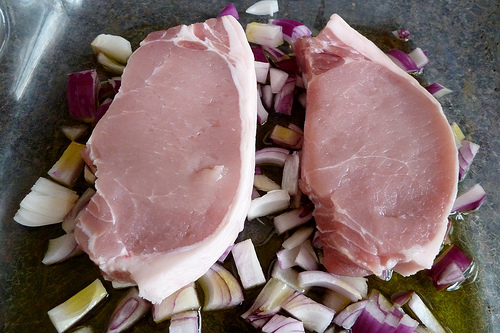
Since we're on the topic of pork chops (and I'm in the middle of my "I Bought An Extreme Value Pack And Now It's Pork Chops For Dinner All Week" week), let's talk about pork. How should you cook it? What do all those cuts mean? And is "the other white meat" a completely meaningless phrase?

Image courtesy Flickr/kendiala
Pork Temperature and Safety
For ages, we have been told to cook pork to 165 degrees in order to ensure that it is safe. Aside from the usual bacteria threats (e. coli and salmonella), pork is a vector for trichinosis, which is a parasitic worm that burrows into muscle tissue and causes excruciating pain.
Industrial animal husbandry has improved (so they say) and trichinosis is incredibly rare in the United States. The USDA recently relaxed its requirements, and now suggests that pork is safe at an internal temperature of only 145 degrees.
The meat is much more tender and less likely to be dried out when cooked to a lower temperature. But frankly, I can't bring myself to do it.

Image courtesy Flickr/sofiagk
White Meat or Red?
This used to be a much bigger deal back in the 80s and 90s when everyone was convinced that fat was the enemy. Red meat tends to be fattier, thus white meat (like chicken) was perceived as being a healthier choice.
Pork branded itself "the other white meat" based on little more than wishful thinking. There are cuts of beef that are lean, and cuts of pork that are fatty, and it's not that big an issue anyway.
If you are watching your fat intake, there is usually very little fat marbling in pork, which means that it's easy to trim the fat off.

Image courtesy Flickr/powerplantop
Decoding cuts of pork
There are basically only two cuts of pork. You've got your "giant thing that works well in the slow cooker" and the "small individual chops." (To clarify, a pork loin or pork tenderloin counts as the latter, even though you may buy it as a single giant piece of meat.) Then you've got ham and bacon, each of which are topics for All About articles in their own right.
Type 1: Giant Thing
These are your pork shoulders, your picnic roasts, and your pork blade steaks. They are usually extremely cheap ($1-$2/lb) because they are also extremely tough. The best thing to do with these is to either slow roast it in the oven, or toss it into the slow cooker.
Pernil is one of the traditional ways to cook a Giant Thing of pork. There are a million different pernil recipes, but I strongly favor this one. (Warning: language NSFW.)
Either way, they will pretty much cook down to an easily-shredded consistency, which means that they are great for use as taco filling, pulled pork sandwiches, and other such shreddy goodness.
Here's a great, incredibly simple recipe for kalua pork I picked up from a friend: put a Giant Thing of pork in the slow cooker. Pour in about half a bottle of liquid smoke. Sprinkle with salt. Cook on low for 8-10 hours. This tastes amazing, but fair warning: the smoke smell while it's cooking is fairly strong. You might want to set up your slow cooker outside or in the garage if you've got one.

Image courtesy Flickr/freecandy13
Type 2: Pork Chops
I have a very loose definition of "pork chop." They vary in price based on the cut (thick or thin, boneless or bone-in) but are usually under $5/lb in my area.
I talked about roasting pork chops in the oven yesterday. I also want to give a shout out to pork tenderloin, which you can find on sale for as low as $2.50/lb. I have a theory that no one buys these cuts (which are always shipped in a shrink-wrapped plastic package - weird) because they don't know how to cook them, which is why they are so cheap.
Luckily, you and I can benefit from everyone else's confusion about what to do with pork tenderloin. There are a lot of things you can do with a tenderloin, but I like to keep it simple. Rub it with salt and pepper (or other spices if you want), stick it in a 9x13 pan, and bake it at 350 until the internal temperature is right. Let it rest for 10 minutes, then slice it into medallions and dig in.
One of my favorite pork rubs is so simple: a tablespoon each of chipotle powder and paprika, and about 1 teaspoon of salt.
Main image courtesy Flickr/@brunvoll

0 comments